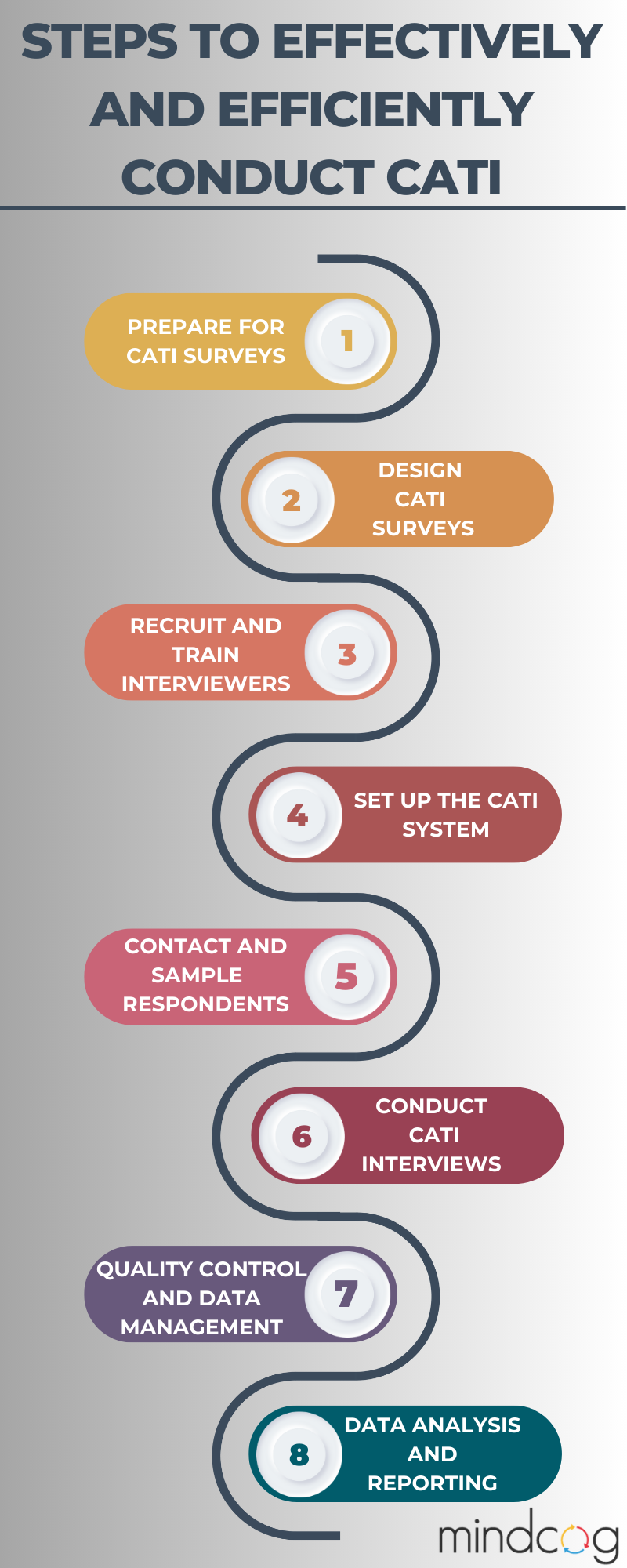In market research, collecting accurate and reliable data is crucial for informed decision-making. Computer-Assisted Telephone Interviewing (CATI) has proven to be a powerful methodology for gathering valuable insights from respondents. By combining the benefits of telephone interviews with computer technology, CATI surveys allow researchers to reach a wide range of respondents and obtain real-time insights. In this article, we will walk you through the process of conducting CATI surveys, providing you with practical tips and best practices for successful data collection.
Let’s first understand what is Computer-Assisted Telephone Interviewing (CATI)?
CATI is a method of conducting market research over the phone using a computer-assisted system. A trained interviewer conducts the entire research over a telephonic conversation using a predefined script and records the responses in a programmed survey. This software helps with question routing, data entry, and quality control, resulting in streamlined data collection and analysis. CATI is particularly useful for large-scale studies, reaching geographically dispersed respondents, and collecting quantitative data.

- Preparing for CATI Surveys: Before diving into CATI surveys, it’s important to lay a solid foundation. Follow these essential steps:
-
- Define Your Research Objectives: Clearly articulate the research objectives and the specific information you aim to gather through CATI surveys. This clarity will guide the entire survey process.
- Identify the Target Audience: Determine the characteristics of the audience you want to survey. Define key demographics and segmentation criteria to ensure your sample is representative of your target audience.
- Create a Survey Questionnaire: Develop a well-structured questionnaire that aligns with your research objectives. Craft clear and concise questions allowing for structured responses as well as qualitative insights.
- Designing CATI Surveys: Designing an effective CATI survey is crucial for obtaining reliable data. Follow these essential steps:
-
- Question Sequence: Arrange the questions in a logical order to ensure a smooth flow of the interview. Start with an introduction, followed by screening questions to ensure respondents eligibility.
- Question Types: Utilise a mix of question types, including closed-ended (multiple-choice, matrix, rating scales) and open-ended questions. Closed-ended questions facilitate easy data entry and analysis, while open-ended questions allow for more in-depth answers.
- Length of the Survey: Keep the survey short to maintain respondent’s interest. Long surveys can lead to respondent fatigue and potentially impact data quality.
- Recruiting and Training Interviewers: Hiring and training skilled interviewers is critical for the success of your CATI study.
-
- Recruitment: Recruit interviewers with strong communication skills, an understanding of market research, and the ability to handle different respondent types and scenarios.
- Training: Provide comprehensive training to interviewers, covering survey objectives, questionnaire administration, probing techniques. Conduct mock interviews and provide feedback to enhance their skills.
- Setting Up the CATI System: For effective data collection, a reliable CATI system must be implemented. Choose software that is appropriate and has capabilities like real-time data entering, question routing, and quality control checks.
Make sure the system is compatible with your data management and analysis tools and can handle the appropriate call volume. Perform extensive testing to confirm the system’s operation and address any potential problems.
- Sampling and Contacting Respondents: Determine the appropriate sampling strategy to ensure your study represents the target population accurately. Random sampling, stratified sampling, or quota sampling can be employed based on your research objectives.
Develop a calling schedule that considers respondents availability. Maintain a professional and courteous approach when contacting respondents to maximise participation.
- Conducting the CATI Interviews: When conducting CATI interviews, interviewers play a critical role in establishing rapport, ensuring respondent engagement, and collecting accurate data. Train interviewers to follow standardised protocols, ask questions precisely, and record responses accurately.
Encourage active listening to obtain detailed and insightful answers. Maintain flexibility in the interview process to accommodate any necessary deviations from the script while ensuring consistency in data collection.
- Quality Control and Data Management: Implementing quality control measures is essential to ensure data accuracy and reliability. Regularly monitor interviews to identify and address any issues promptly.
Double-check responses, conduct data validation checks, and implement verification procedures to minimise errors. Regularly back up collected data and ensure secure storage to protect respondent privacy.
- Data Analysis and Reporting: Once data collection is complete, it’s time to analyse and derive meaningful insights from the collected data. Here’s how:
-
- Data Cleaning: Review the collected data for completeness, accuracy, and consistency. Clean the dataset by finding any missing values, or inconsistencies.
- Data Analysis: Utilise statistical software or data analysis tools to examine quantitative data and identify patterns, correlations, and trends. For qualitative responses, use thematic analysis to identify recurring themes and insights.
- Data Interpretation: Interpret the results in light of your research objectives. Look for patterns, trends, and correlations that provide actionable insights for your business or organisation.
CATI surveys offer a powerful means of gathering valuable data through telephone interviews. By following these steps and best practices, you can conduct CATI surveys effectively and obtain high-quality insights for your market research projects. Remember to prioritise quality control, interviewer training, and respondent engagement to ensure accurate and reliable data collection.

